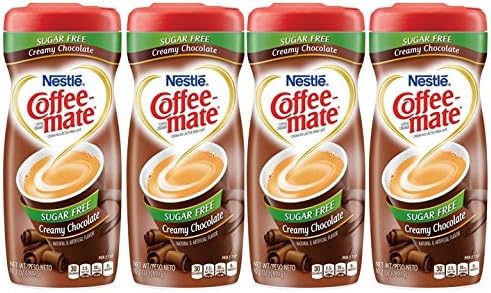
The Rise of Sugar-Free Powdered Coffee Creamer: A Deep Dive
The morning ritual. For many, it’s a sacred time, a moment of quiet contemplation before the day’s demands take hold. And at the heart of this ritual, often, is coffee. But coffee, in its purest form, can be a bit… austere. That’s where the creamer comes in. But in today’s health-conscious world, the traditional, sugar-laden options are facing a challenge. Enter the sugar-free powdered coffee creamer, a product that has rapidly gained popularity, offering a guilt-free way to customize your caffeine fix. This article will delve into the world of sugar-free powdered coffee creamer, exploring its benefits, ingredients, market trends, and potential drawbacks. We’ll examine why this product has resonated with consumers and what the future might hold for this increasingly popular alternative.
The Appeal of Sugar-Free Options
The shift towards healthier eating habits is undeniable. Consumers are increasingly aware of the impact of sugar on their health, leading to a greater demand for low-sugar and sugar-free alternatives. This trend has fueled the growth of the sugar-free powdered coffee creamer market. The key drivers behind this shift include:
- Health Concerns: Increased awareness of the link between excessive sugar intake and health problems such as obesity, type 2 diabetes, and heart disease.
- Dietary Restrictions: The rise of dietary restrictions like keto, paleo, and low-carb diets, which often exclude or severely limit sugar consumption.
- Taste Preference: Some individuals simply prefer the taste of unsweetened coffee or enjoy the flexibility of adding their own sweeteners.
The sugar-free powdered coffee creamer addresses these concerns by providing a way to enhance the coffee experience without the added sugar. It allows individuals to enjoy the flavor and richness of creamer while adhering to their dietary goals.
Decoding the Ingredients: What’s in a Sugar-Free Powdered Coffee Creamer?
Understanding the ingredients is crucial for making informed choices. A typical sugar-free powdered coffee creamer composition often includes the following:
- Non-Dairy Creamer: This is the base ingredient, providing the creamy texture. It’s often made from ingredients like hydrogenated vegetable oil, corn syrup solids, and sodium caseinate.
- Sweeteners: These are the key components that replace sugar. Common options include:
- Artificial Sweeteners: Such as sucralose, aspartame, and acesulfame potassium. These offer a high level of sweetness with minimal calories. However, their long-term health effects are still debated.
- Sugar Alcohols: Like erythritol, xylitol, and maltitol. These sweeteners provide a similar sweetness level to sugar but with fewer calories. They can sometimes cause digestive issues for some individuals.
- Stevia and Monk Fruit: These are natural, zero-calorie sweeteners derived from plants. They are generally considered safe and offer a clean taste.
- Thickeners and Stabilizers: Ingredients like dipotassium phosphate, sodium stearoyl lactylate, and cellulose gum are added to maintain the creamer’s texture and prevent clumping.
- Flavorings: Artificial or natural flavorings are used to create various flavors like vanilla, hazelnut, and caramel.
- Coloring Agents: These are added to enhance the visual appeal of the creamer.
It is important to carefully review the ingredient list of any sugar-free powdered coffee creamer to ensure it aligns with your dietary needs and preferences. Consider the type of sweetener used and any potential allergens or sensitivities.
Market Trends and Consumer Preferences
The sugar-free powdered coffee creamer market is experiencing significant growth, driven by the factors mentioned earlier. Key trends include:
- Increased Product Variety: Manufacturers are expanding their product lines to cater to diverse consumer preferences, including different flavors, sweetener options, and dietary needs (e.g., vegan, gluten-free).
- Focus on Natural Ingredients: There is a growing demand for creamers made with natural sweeteners and fewer artificial ingredients. Consumers are increasingly seeking “clean label” products.
- Convenience and Accessibility: Sugar-free powdered coffee creamer is readily available in most grocery stores, online retailers, and coffee shops, making it a convenient option for consumers.
- Sustainability Concerns: Some brands are focusing on sustainable packaging and sourcing practices to appeal to environmentally conscious consumers.
Consumer preferences are also evolving. While taste remains a primary factor, consumers are also paying attention to ingredient quality, nutritional value, and brand transparency. The ideal sugar-free powdered coffee creamer offers a delicious taste, minimal calories, and a clean ingredient profile.
Potential Drawbacks and Considerations
While sugar-free powdered coffee creamer offers numerous advantages, it’s essential to be aware of potential drawbacks:
- Artificial Sweeteners: Some individuals may experience side effects from artificial sweeteners, such as headaches, digestive issues, or allergic reactions. Further research is ongoing about the long-term effects of these sweeteners.
- Sugar Alcohols: Sugar alcohols can cause bloating, gas, and diarrhea in some individuals, especially when consumed in large quantities.
- Processed Ingredients: Many creamers contain processed ingredients, such as hydrogenated oils and artificial flavorings, which may not be ideal for overall health.
- Nutritional Value: While sugar-free powdered coffee creamer is often low in calories, it may not provide significant nutritional value. It’s primarily used for taste and texture enhancement.
It’s crucial to consume sugar-free powdered coffee creamer in moderation and to listen to your body. If you experience any adverse effects, consider switching to a different product or consulting with a healthcare professional.
Comparing Sugar-Free Options: Powdered vs. Liquid
Sugar-free powdered coffee creamers are often compared to their liquid counterparts. Both offer sugar-free alternatives, but they have different characteristics:
- Powdered Creamers:
- Pros: Convenient, shelf-stable, often contain fewer calories than liquid creamers, offer a longer shelf life.
- Cons: May contain more processed ingredients, can sometimes clump, and the flavor might not be as rich.
- Liquid Creamers:
- Pros: Generally have a richer flavor and creamier texture, often contain fewer processed ingredients.
- Cons: Require refrigeration, have a shorter shelf life, may contain more calories, and can sometimes separate.
The best choice depends on individual preferences and lifestyle. Powdered creamers are ideal for convenience and long-term storage, while liquid creamers may appeal to those seeking a richer flavor and texture.
Making the Right Choice: Tips for Choosing a Sugar-Free Powdered Coffee Creamer
Choosing the right sugar-free powdered coffee creamer involves careful consideration. Here are some tips:
- Read the Ingredient List: Pay close attention to the ingredients and choose a product that aligns with your dietary needs and preferences. Look for creamers with natural sweeteners and fewer artificial additives.
- Consider the Sweetener: Determine which sweetener option works best for you. Stevia and monk fruit are often preferred for their natural origin and zero-calorie profile.
- Check the Nutritional Information: Compare the calorie, fat, and carbohydrate content of different creamers.
- Evaluate the Flavor: Choose a flavor that you enjoy and that complements your coffee.
- Read Reviews: Check online reviews to get insights from other consumers about the taste, texture, and overall quality of the creamer.
- Start Small: Try a small package of a new creamer before committing to a larger size.
Making an informed decision will help you find a sugar-free powdered coffee creamer that you can enjoy without compromising your health goals.
The Future of Sugar-Free Coffee Creamer
The future of the sugar-free powdered coffee creamer market looks promising. Several factors are expected to drive continued growth:
- Innovation: Manufacturers are likely to continue innovating with new flavors, sweetener options, and healthier ingredient formulations.
- Increased Consumer Demand: The demand for sugar-free and low-sugar products is expected to remain strong, further fueling the growth of the market.
- Expansion of Distribution Channels: Sugar-free creamers will likely become even more accessible through various retail channels, including online platforms and coffee shops.
- Focus on Sustainability: Brands are expected to prioritize sustainable practices, such as eco-friendly packaging and ethical sourcing.
The evolution of sugar-free powdered coffee creamer reflects a broader trend towards healthier and more customized food choices. As consumers become more discerning, the industry will need to adapt to meet their evolving needs and preferences.
Conclusion: Embracing the Sugar-Free Coffee Experience
The sugar-free powdered coffee creamer has become an increasingly popular choice for coffee lovers who are looking for a healthier and more customizable alternative to traditional creamers. While understanding the ingredients and potential drawbacks is crucial, the benefits of enjoying a delicious cup of coffee without the added sugar are undeniable. By making informed choices, consumers can find a sugar-free powdered coffee creamer that enhances their coffee experience while supporting their health goals. The future of this market looks bright, with continued innovation and a focus on meeting the evolving needs of health-conscious consumers. This product offers a perfect blend of taste and well-being for those who appreciate the perfect cup of coffee.
[See also: Related Article Titles]

